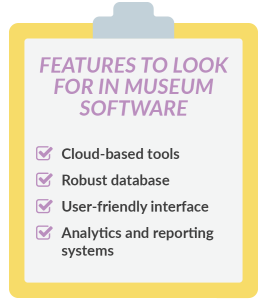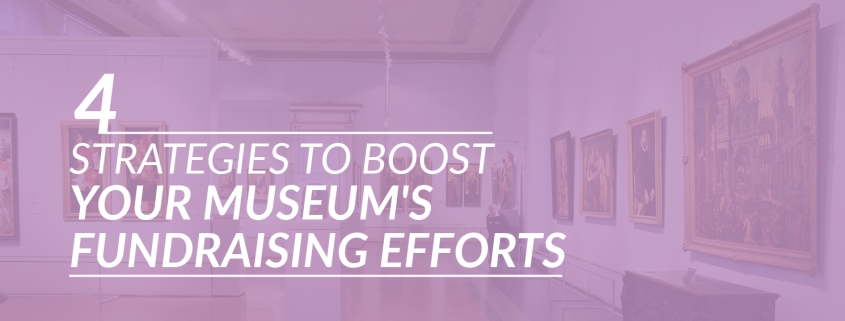4 Strategies to Boost Your Museum’s Fundraising Efforts
If you’re a leader at a museum, you’ve likely spent a good deal of time thinking about how to create a sustainable funding model for your organization. When you consider your museum’s revenue streams, ticketing likely comes to mind first. However, museum revenue generation as a whole is much more complicated.
Research shows that all forms of earned income—admissions, merchandise sales, program participation costs, etc.—only comprise 40-70% of a museum’s funding. The remaining 30-60% comes from various contributions—grants, endowments, and individual donations—meaning it’s important not to neglect your fundraising efforts to maximize your revenue generation potential.
To boost the amount of individual donations your museum brings in, this guide will walk through four top fundraising strategies for organizations like yours, including how to:
- Segment Your Donors
- Host Fundraising Events
- Focus on Your Membership Program
- Invest in Specialized Fundraising Software
Implementing these strategies will help your museum keep ticket, merchandise, and educational program costs reasonable for visitors while still bringing in enough revenue to fund all of your initiatives. Let’s get started!
1. Segment Your Donors
The first step in asking your museum’s supporters for donations in a way they’ll be receptive to is to understand them as individuals. Segmentation—the process of grouping your donors based on shared characteristics—is one of the most effective ways to do just that.
Review your museum’s donor data management system to locate relevant information that you can use in the segmentation process, such as supporters’:
- Demographics: age, location, education, family status, and wealth
- Giving history: average donation amount, giving frequency and recency, and preferred donation method
- Engagement history: event attendance, educational program participation, membership status, and communication preferences
Then, use this data to create your donor segments. For example, you might have one group of older, wealthy donors who give at the end of every year by mailing in a check and another group of Millennial supporters who donate more sporadically through your mobile giving page.
Based on what you know about these segments, send targeted communications to encourage them to give an amount that aligns with their past donations through their preferred channel.
2. Host Fundraising Events
Events are a popular fundraising method among many nonprofits, including museums. Not only do they typically have a high return on investment, but they also bring your community together around their shared passion for supporting your organization.
Some types of fundraising events that work particularly well for museums include:
- Galas. Since galas are among the most formal event fundraisers, they’re especially useful for attracting mid-level to major donors. They typically include dinner, entertainment, speeches by organizational leaders or guests, and time for socializing.
- Auctions. Auctions are highly flexible—you can choose either a live or silent auction and host it in person, virtually, or in a hybrid format. To maximize your fundraising event revenue, procure high-value auction items that appeal to your supporter base.
- Sip-and-paint parties. These events are especially popular among art museums. Set up paints and canvases in a large space (outdoors if possible), and offer a selection of wines, nonalcoholic drinks, and light snacks for attendees to enjoy as they create their own art. To fundraise, charge an entrance fee and set up a donation jar.
For any of these events to succeed, careful planning is essential. In addition to solidifying logistics and ensuring you have all of the materials you need, take time to create a positive experience for participants that will encourage them to continue supporting your organization.
3. Focus on Your Membership Program
Although membership fees fall into the earned income category of museum funding, they’re one of the most reliable revenue streams within that 40-70% mentioned earlier. Plus, since your members are loyal supporters of your organization, they may be more willing to participate in fundraising events or make additional donations.
Convert more of your organization’s visitors into members by:
- Offering a variety of membership benefits. According to Double the Donation, these may include anything from free or discounted admission to members-only events and early access to special exhibitions.
- Creating membership tiers. With a tiered structure, members can choose a plan that aligns with their budget and commitment to your organization, and those at higher levels can receive more perks in exchange for their higher contributions.
- Broadly advertising your membership program. Leverage your museum’s website, social media, email marketing, and direct mail to recruit new members from among your repeat visitors and program participants.
In addition to recruiting new members, make sure to have a plan for retaining existing members. Send out membership renewal reminders each year to boost re-enrollment in the program, and collect and apply member feedback to continuously improve your offerings for members.
4. Invest in Specialized Fundraising Software
Between creating targeted donation asks, hosting fundraising events, and managing memberships, museum fundraising involves a lot of moving parts. Fortunately, there are tools designed specifically for organizations like yours to help boost revenue and engage supporters through every step of the donor journey.
Doubleknot’s museum software guide recommends looking for a solution with the following features:

- Cloud-based tools for membership management, donation processing, event planning, and supporter communications.
- A robust constituent relationship management system or integrations with third-party solutions that securely store information about your visitors, members, and donors.
- A user-friendly interface to make it easy for anyone on your team to add or view information.
- Complete analytics and reporting systems so you can see what is working in your fundraising strategy and where you can improve.
Additionally, make sure your software is customizable so it can more effectively help you meet your museum’s needs and achieve your goals.
As you put these fundraising strategies into practice, continue to collect and analyze data on giving, event attendance, memberships, and supporter engagement so you can hone your efforts over time. With the right tools and a bit of creativity, you’ll be able to optimize your fundraising, boost the contributions side of your budget, and develop a more sustainable revenue generation plan.




